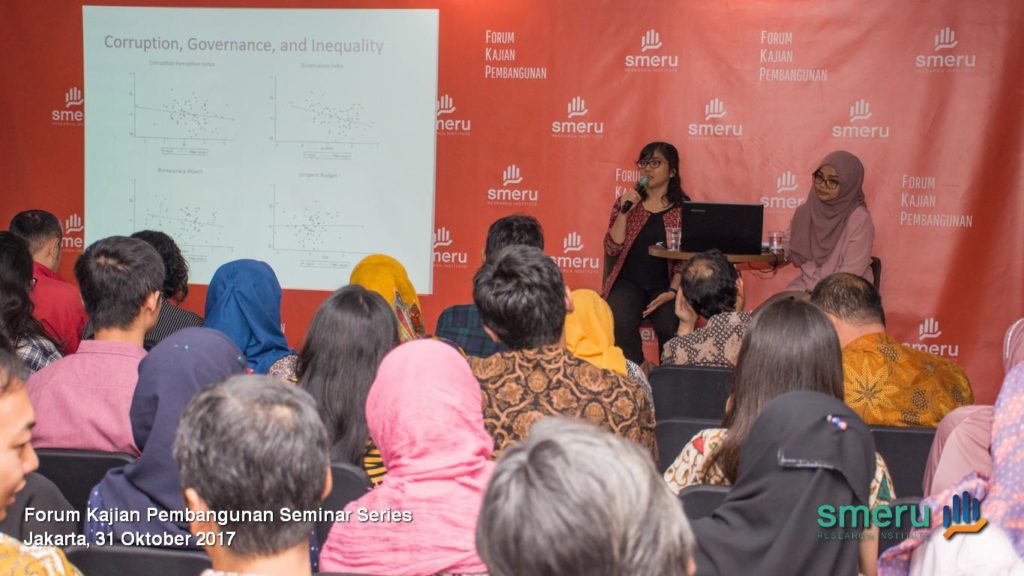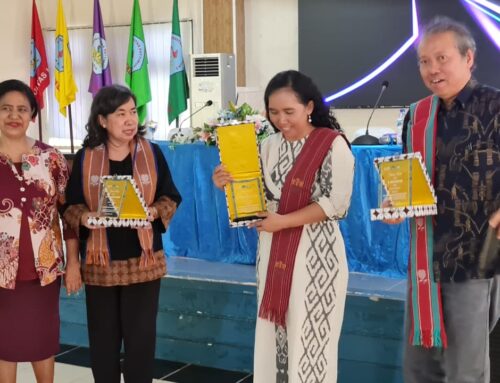The FKP seminar on 31 of October 2017, held by SMERU Research Institute, was titled Corruption, Governance, and Inequality in Indonesia, which was presented by Mayang Rizky (SMERU Research Institute). One of the things that motivate the research is the act of growing decentralization done by the government of Indonesia. As decentralization is sprouting, good governance and equality need to be established, and corruptions needs to be eradicated, but, before these can be achieved, a study is needed in order to understand all of these occurrences.
Decentralization can be seen in the growing number of provinces and districts from the year 1999 to the year 2015. Widespread of welfare is the ideal condition hoped to be achieved by decentralization. This is done by giving district level government greater ability to adopt regulation proper to their local situation and needs. But, this may be too far-fetched as inequality seem to be growing from the year 2001 to 2017, which is the opposite of what decentralization is aiming for which is enhanced welfare. Previous research on inequality rely mostly on monetary aspects, hence, the current research is unique because it focuses also on governance and corruption.
There have been 3.099 corruption cases in Indonesia, 135,88 trillion rupiahs of total loss, and 13,5 trillion rupiahs of total fines from the year 2001 until 2015 based on UGM corruption monitor. This is the reason for the loss of the public trust to the government, stated by Mayang, which will then affect the business environment, tax revenue, and participation of the poor in social assistance program. Mayang shows that the corruption perception index is increasing over the year, from 4.12 in 2006 to 4.83 in 2010. The corruption variable was obtained from the corruption perception index, which was constructed by surveying how people perceive corruption. The governance variable was also form through surveying a number of provinces such as, Maluku Utara, Papua Barat, Jambi, Jakarta, and Yogyakarta to name a few.
By comparing side by side scatter plots of corruption perception index, governance index, bureaucracy index, and unspent budget, Mayang stated that, it can be seen in those scatter plot, as corruption declines and good governances increase, inequality declines. The 3 questions asked in the research are (1) does less corruption lead to reduced inequality? (2) does good governance lead to reduced inequality? and (3) which aspect of good governance will lead to a reduction in inequality?
The preliminary findings of the research state that, corruption will lead to increased inequality, good governance will lead to decreased inequality, and higher degree of decentralization will lead to increased inequality. This last finding is somewhat of an anomaly because it shows the opposite of what outcome is hoped to be achieved by decentralization. This anomaly seems to stimulates the audience, because, during the questions and answers session, many was focusing on how and why did this anomaly occur. This unending line of questions might be seen as a plea for more research focusing on the mentioned topic.

![[FKP hosted by Universitas Padjadjaran] Kesehatan ibu pasca melahirkan di Indonesia](https://www.fkpindonesia.org/wp-content/uploads/2024/02/fkp-2024-02-21-thumbnail-500x383.jpg)

![[FKP hosted by ANU Indonesia Project] The pursuit of food self-sufficiency in Indonesia: food-trade policy preferences during the administrations of Yudhoyono (2004-2014) and Widodo (2014-present)](https://www.fkpindonesia.org/wp-content/uploads/2024/01/fkp-2024-01-16-500x383.jpg)
![[FKP hosted by ANU Indonesia Project & SMERU] Prepayment, price, and welfare: a study on electricity demand in Indonesia](https://www.fkpindonesia.org/wp-content/uploads/2023/02/fkp-2024-01-19-thumbnail-summary-500x383.png)
